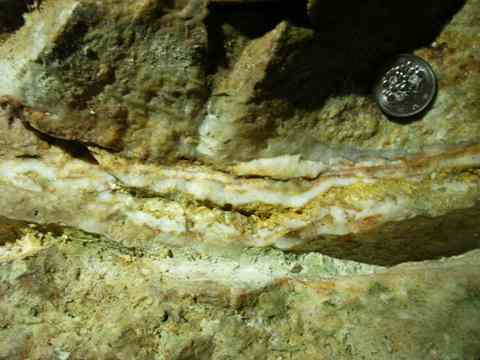Takatama Mine
Tamagawa, Atami village, Koriyama city, Fukushima pref., Japan
Occurrence
Low temperature hydrothermal Au-Ag deposit in quartz vein associated with rhyolite dikes intruded in sandy to muddy tuff of late Miocene (10 Ma) Takatama Formation (Shiroishi Formation). Takatama Formation is the caldera lake-fill deposit. The rhyolite dikes are considered as volcanic vents of the early Pliocene (5.0 Ma) Iwane Rhyolite. The Iwane Rhyolite is the post-caldera volcanic rocks. Ages of sediments were determined by microfossils.

Gold-bearing quartz vein in sandy tuff of Takatama Formation (Shiroishi Formation). The white vein is composed of quartz and adularia, and the brown zones in the vein are rich in gold. The black zone just below the coin is rich in silver. The pale brown host at the both sides of the vein is silicified sandy tuff.
Reported Minerals
- Gold
- Gold-bearing quartz
- Adularia
- Cerargyrite
- Argentite
- Wavellite
Mineral Assemblages
- Quartz(Gangue) - Adularia(Gangue) - Gold
- Quartz(Gangue) - Cerargyrite
History
- 1600's: The deposit was mined by Ujisato Gamo who ruled this region.
- 1886: Kenji Matsuura mined Au.
- 1890: Syosaku Koeda mined Au.
- 1976: The mine was closed.
Localities
- Shobusawa (Izu Peninsula)
- Seikoshi Mine (Izu Peninsula)
- Toi Mine (Izu Peninsula)
- Tensho Mine (Izu Peninsula)
- Takatama Mine (Gold/Silver deposit)
- Nishizawa Mine (silver sulfides)
- Nebasawa Mine (Gold/Silver deposit)
- Hishikari Mine (Kyusyu Island)